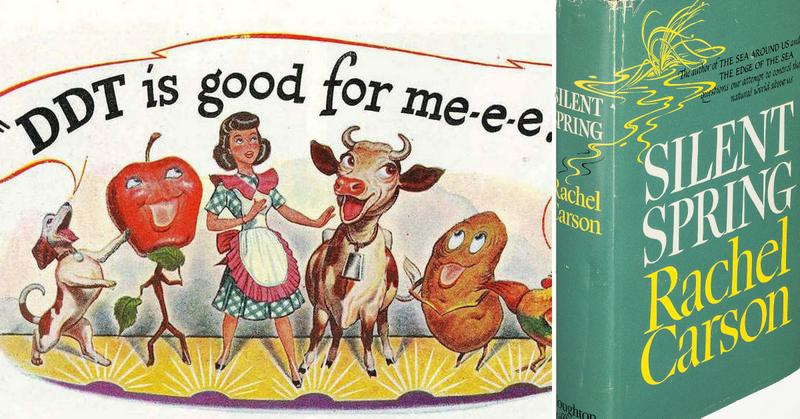How The Chemical Companies Fought 'Silent Spring's Inconvenient Truth
By | September 26, 2020

Rachel Carson's 1962 book Silent Spring questioned the use of pesticides, particularly DDT. Despite, and because of, chemical companies' campaign to discredit the book, it was widely read and it changed the way Americans felt about chemicals, public health and the environment. In postwar America, also known as the Atomic Age, there was a prevailing sense that scientific advances were improving Americans' lives more and more every day. The thought that American industry might be profiting by selling or using chemicals that had harmful effects went against the era's optimism about chemistry's benefits. Carson's book motivated Americans to question the use of chemicals and pesticides in their foods, and was a landmark text in the environmental movement that would gain momentum throughout the decade.

The Chemical That Would Create A Silent Spring
DDT, which was developed in 1939, first received notice when it was used during World War II to clear malaria-causing insects from South Pacific islands for American soldiers. The chemical, which was also being used as a delousing powder in Europe, was unusually effective in that it killed hundreds of different types of insects, rather than targeting only one or two; the inventor of DDT won the Nobel Prize. It became available for civilian use in 1945. Rachel Carson was one of only a few people to express concern over the use of the chemical.

Carson Was Not Just A Hysterical Woman
Carson, who grew up in Pennsylvania, was a former marine biologist with the U.S. Fish and Wildlife Service. Despite the portrait Carson’s detractors tried to paint of her, she was highly educated as she had been a graduate student at Johns Hopkins, but was forced to leave to help her family financially during the Great Depression prior to working towards her doctorate. She then took a job working for the Bureau of Fisheries. After she published The Sea Around Us, she achieved financial success and was able to focus on writing full-time. As a result of The Sea Around Us, she was also awarded two honorary doctorates.

Inspiration To Raise Her Voice
While she was aware of DDT, she decided to write about it after she received a letter from a friend who was concerned about the numbers of birds dying on Cape Cod as a result of DDT spraying. Carson tried unsuccessfully to convince magazines to publish articles about the chemical. Since she was already a successful writer and had collected significant research on the subject, she decided to write the book that would become Silent Spring. The book took four years to complete and detailed the process by which DDT entered the food chain and led to cancer and genetic damage. She also explained how DDT remained in the environment even after rainfall. The title was meant to evoke images of a Spring with no birdsong.

The Companies Strike Back
The book was first serialized in The New Yorker in June 1962, startling readers who then sent calls for action to governmental agencies; this drew the ire of the chemical industry. Pesticide manufacturing companies launched a campaign to discredit Carson, spending $250,000. They tried to sue the publisher to stop publication of the book. One executive for the American Cyanamid Company complained that "If man were to faithfully follow the teachings of Miss Carson, we would return to the Dark Ages, and the insects and diseases and vermin would once again inherit the earth." Monsanto produced a parody of Silent Spring titled “A Desolate Year,” claiming that disease and famine would run amok in a world where pesticides had been banned. However, Silent Spring was not a hysterical call for the banning of all pesticides, but rather for more study and consideration before making decisions which would impact the environment. In a 1963 editorial entitled “The Myth of the ‘Pesticide Menace’” published in The Saturday Evening Post, a former science editor, Edwin Diamond, critiqued the book. Diamond, who was originally going to be a coauthor of Silent Spring, did little more than question her credibility and raise rhetorical questions such as why “an industrialist or a scientist…would poison our food and water — the same food and water he himself eats and drinks?”

The Attacks Become Personal
Carson had to endure personal attacks as well, from questions posed about her credibility since she was not affiliated with an organization at the time of publication. Her integrity and her sanity were also questioned. She was called radical, unscientific, disloyal, and hysterical. In Time, for example, her argument was called “unfair, one-sided, and hysterically overemphatic,” and she was claimed to have a “mystical attachment to the balance of nature.” Some even questioned why she, an unmarried woman, would be concerned about genetics. The campaign against the book had an unintended effect: the sales of it reached a million by the time she died.

Long Term Results
She was aware of the potential for the reactions she faced and prepared for them. Sadly, she had been diagnosed with malignant breast cancer which had metastasized in 1961, but she kept it a secret as she knew that the companies would use it against her. In preparation for these attacks, prior to publication, she had prepared, including 55 pages of notes and a list of experts who had read the manuscript. Eminent scientists rose to her defense and President Kennedy ordered the President’s Science Advisory Committee to examine the issue, leading to not only Carson’s vindication but also to the close governmental supervision of the chemical.
Carson died in 1964 and did not see the fruit of her actions. In 1970, the Environmental Protection Agency was formed and then, 1972, DDT was banned. The fight over DDT also caused a shift in the dialogue regarding pesticides; the question was no longer if they were dangerous, but rather, which ones were dangerous. In 1980, President Jimmy Carter posthumously awarded her the Presidential Medal of Freedom.
